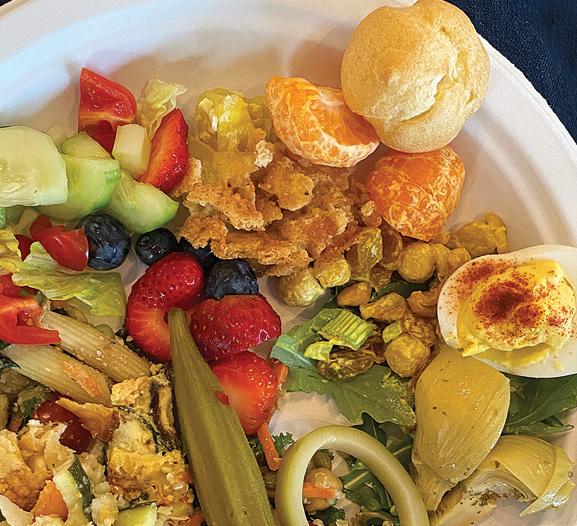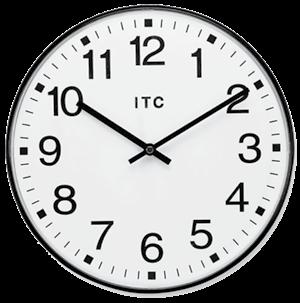
5 minute read
Be Well with Samantha Steele
Intermittent Fasting
By Samantha Steele
Be Well
Due to all the special treats, festivities and celebrations, the holiday season is notorious for adding on unwanted pounds, but what about that special new dress or outfit that you want to don at the holiday party? Is there a way we can enjoy holiday celebrations yet still maintain, even lose weight? As a more “mature woman,” I’ve struggled to maintain and lose weight, so believe me I’ve tried everything. My favorite and most successful plan? It’s called Intermittent Fasting (IF).
Fasting is historically common-place, as it has been a part of spiritual practice for millennia. But modern science has confirmed there are many good reasons for fasting. Intermittent Fasting relies on “windows” of consumption and fasting that are alternated daily, resulting in the benefits of fasting while not requiring long periods of abstinence. Fasting allows humans to use stored fat as a source of fuel instead of glucose, naturally decreasing the number of fat cells in the body. This is important not only for improved Body Mass Index (BMI), but also because the fewer fat cells a body has, the less likely it will experience insulin resistance or diabetes. For many, Intermittent Fasting has been beneficial in so many ways, and we have seen studies that show:
Reduced inflammation in both the body and brain, and a decrease in free radical damage
Weight loss/weight management paired with improved BMI
Healthier longevity
Improved brain health—fasting can stimulate the glymphatic system, the brain’s own powerwash to detoxify
Autophagy, or the body cleaning out damaged cells to regenerate newer, healthier cells
Normalization of one’s insulin sensitivity
Normalization of ghrelin levels, also known as “the hunger hormone”
Promotion of human growth hormone (HGH) production, which plays an important role in health, fitness and slowing the aging process
Decrease in triglyceride levels
In an article titled “Effects of Intermittent Fasting on Health, Aging, and Disease” published in the renowned New England Journal of Medicine, researchers found that:
“Simple fasting improves metabolism, lowers blood sugar, and lessens inflammation, which improves a range of health issues from arthritic pain to asthma; and even helps clear out toxins and damaged cells, which lowers risk for cancer and other diseases while enhancing brain function.”
Have I gotten your attention yet? Want to learn more?
Here are some different options for IF:
16/8—Fast for 16 hours, eat during an eight-hour window 5/2—Eat healthy meals for five days, limit consumption for two days per week
OMAD—Eat one meal a day
Complete Fast—Eat every other day (used mostly for obesity)
For the 16/8 fast, you will be “fasting” for 16 hours, and “feasting” during the eight-hour window. For example, you might eat your first meal at 12 p.m., and stop eating by 8 p.m. each day. You may also start and end the day with noncaloric beverages such as black coffee or tea, and filtered or mineral water. You may prefer to break your fast earlier, at 10 a.m., for instance, but then you will need to end your eating window by 6 p.m. It is completely fine to adjust accordingly on a daily basis. There is no need to follow the same schedule, only the time frame.
For “beginner” fasters, those who have not fasted in the past, or for those who just might want to start slowly, I suggest starting with a 10- or 12-hour eating window, and a 14- or 12-hour fast. For example, with a 12-hour fasting/feasting window, eat your first meal at 7 a.m., and stop eating by 7 p.m. each day.
The 5/2 fast is basically when you eat normal, balanced meals for five days and then limit calories for two days: up to 500 calories for women, and 600 calories for men. The last two types, OMAD and the complete fast every other day, are selfexplanatory.
Here are a few guidelines as you begin an IF regimen:
Pick the protocol that works with your fitness level and lifestyle.
Give your body time to adjust! Drink plenty of pure water, green tea, or lemon water during your periods of fasting. This helps hydrate you, stave off hunger, and mobilize fat. It will also facilitate detoxification during your fast.
Exercise during a fast for an extra boost of fat loss. Morning walks and strength training during the fast window



can help reduce body fat due to the elevated levels of growth hormone. If you get lightheaded, drink plenty of water and add clean electrolytes such as Celtic sea salt.
Consume high quality, nutrient dense foods during your eating window. I strongly recommend foods containing plenty of healthy fats such as farm eggs (eat the yolks!); ghee, grass-fed butter, whole milk products and meat from hormone-free, antibiotic-free, grass fed cows; fatty, wild fish such as Sea Bass, Alaskan salmon, sardines with (skin and bones), and fish roe; and raw almonds, walnuts, pumpkin seeds, and coconut oil. Also eat plenty of organic greens, cruciferous vegetables such as broccoli, Brussels sprouts, and cabbages, and root vegetables such as sweet potatoes, onions, garlic, beets, turnips, and carrots.
Be flexible. Are you going on a road trip? Make that a fast day and avoid unhealthy fast food. Or pack a cooler with plenty of fluids and healthy meals.
Take the opportunity to incorporate other healthy habits with Intermittent Fasting. Rise and fall with the sun. Get in bed when it’s dark, and turn off your phone, computer and television to maintain melatonin release. Stop snacking and stick to eating one to three times per day. Drink only non-caloric drinks between meals.

Are you ready to get started?
Take it easy and start slow. Talk with your personal health professional for further guidance. Samantha Steele is a nutritionist, food scientist and herbalist who loves spending time outside foraging for wild foods while appreciating the abundance of God’s creation. She can be contacted at cmlmag3@gmail.com. The views are those of the author and should not be considered medical advice. Please consult your personal physician or healthcare professional before making changes to any treatments, regimens or diets.
References:
Intermittent Fasting And Human Metabolic Health. Patterson et al. https://www.ncbi.nlm.nih.gov/pmc/ articles/PMC4516560/
Metabolic Effects of Intermittent Fasting. Annual Review of Nutrition, August 2017. Early Time-Restricted Feeding Improves Insulin Sensitivity, Blood Pressure, and Oxidative Stress Even without Weight Loss in Men with Prediabetes. Cell Metabolism, May 2018. Effects of intermittent fasting on health, aging, and disease. de Cabo R, Mattonson MP. New England Journal of Medicine, December 2019. The Fast Diet; by Dr. Michael Mosley and Mimi Spencer The 5:2 Diet Book; by Kate Harrison Circadian rhythm disruption in cancer biology. Savvidis C, Koutsilieris M., Mol Med. 2012; 18:1249–1260.










